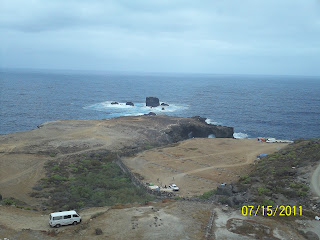The last day before we went for a trip. It is called Gran Canaria
Highlight which means that it departured from Maspalomas and went to Las Palmas Las Palmas
Ezt azért tartottuk fontosnak megnézni, mert a sziget belseje tele van hegyekkel, + amit a wikipedia is ír: "amíg a sziget északi részén csapadékos éghajlatot találunk buja növényzettel és banánültetvényekkel, közepe kopár "holdbéli táj", déli partja pedig száraz, szinte sivatagos. Így aztán északon fejlett a mezőgazdasági élet: a vulkánok lankáin nem ritkák a szőlő-, banán- vagy dohányültetvények."
We thought it is very important to see because there are lots of hills in
the middle of the island and the climate and vegetation always changed. As the
Hungarian Wikipedia states: at North the climate is rainy with lush vegetation
and banana plants, the middle of the island is bare, at South is very dry with
desert. Therefore at North the agriculture is developed so you can find grape,
banana and tobacco there.
We found the advertisement of this trip at the
reception of Tisalaya
Park
Maspalomas után Playa del Inglés felé vettük az irányt, felvéve a többi utast. Ezután első állomásunk Telde volt. Telde az egyik legrégebbi és a második legnagyobb város Gran Canaria-n. Ebben a városban fél órát töltöttünk el.
From Maspalomas we went to Playa
del Inglés to pick up the other passengers. After that the first stop was
in Telde. Telde is one of the oldest
cities and the biggest city in Gran Canaria. We spent half an hour here.
Megyünk felfelé a főváros felé, vagyis az "esősebb" idő felé, tehát már megjelennek a banánültetvények is.
As we went towards to the capital city, the climate was getting
rainy so we could see banana plants.
Ezután buszból megnéztük a fővárost, és elindultunk a sziget belseje felé.
After that we saw the capital city from the bus, and our trip continued
towards to the middle of the island.
A következő állomás Arucas, ahol megnéztük a modern- gótikus stílusú templomot, aminek építése 1909-re nyúlik vissza.
The next stop was Arucas, where we saw a church in modern- gothic
style what was built in 1909.
Mivel a mi képeinknek annyira nem lászik a templom teljes nagyságában, ezért a lowcost oldaláról szedtem le egy képet:
Because you can not see the whole size of the church on our picture,
I found this picture on the lowcost website:
Itt is körülbelül fél órát- 40 percet töltöttünk el.
We spent about half an hour, forty minutes here.
Ezek a képek Arucastól Terorig vezető úton készültek. Egyre mentünk feljebb és feljebb 800- 1000 méter magasságig, így az időjárás is folyamatosan változott. Telde-ben fáztam rövid nadrágban, itt szétfagytam :) Az időjárás mellett a növényzet is folyamatosan változik, ha kinagyítjátok a képeket jobban látszik.
These pictures had been taken from Arucas to Teror. As we went
higher until 800-1000m the weather changed continuously. I was cold in Telde in
shorts, but I was very cold in Teror. As the weather, the vegetation also changed
if you click on the pictures you can see them in bigger size.
Ültetvények végig az út mellett:
We could see plants next to the road:
Gran Canaria-ban több vízvezeték van, mint út. Az év nagy részében nem esik eső, maximum északon felhős és hidegebb az idő. Ezért amikor esik az eső mindent megtesznek azért, hogy megmaradjon a víz, ezáltal tudják öntözni a növényeket. A víz ára is az eső függvényében emelkedik az ültetvényesek számára- ha sok eső esett olcsóbb, ha nem, nyilván jóval drágább.
There are more aqueducts than roads in Gran Canaria. Most of the
year it does not rain, but the North is always cloudy and cold. Therefore when
it rains people do everything to remain the water to water the plants. The
price of the water depends on the weather for the planters, if it rained a lot
that means the price is cheap or vice versa.
Az előző bejegyzéseket Gran Canaria-ról itt1, itt2 és itt3 megnézheted.You can read the previous post here1, here2 and here3.


















